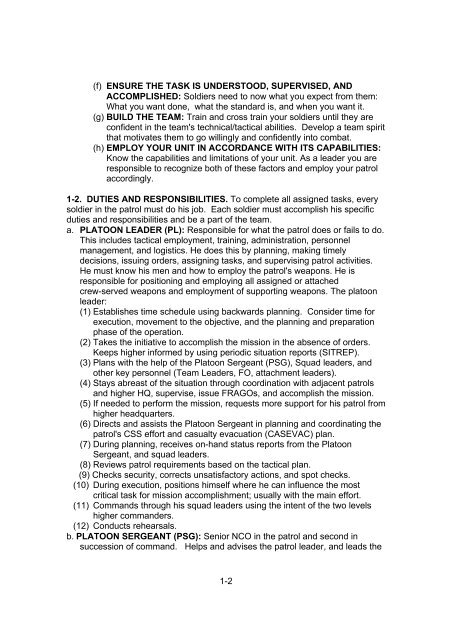You also want an ePaper? Increase the reach of your titles
YUMPU automatically turns print PDFs into web optimized ePapers that Google loves.
(f) ENSURE THE TASK IS UNDERSTOOD, SUPERVISED, AND<br />
ACCOMPLISHED: Soldiers need to now what you expect from them:<br />
What you want done, what the standard is, and when you want it.<br />
(g) BUILD THE TEAM: Train and cross train your soldiers until they are<br />
confident in the team's technical/tactical abilities. Develop a team spirit<br />
that motivates them to go willingly and confidently into combat.<br />
(h) EMPLOY YOUR UNIT IN ACCORDANCE WITH ITS CAPABILITIES:<br />
Know the capabilities and limitations of your unit. As a leader you are<br />
responsible to recognize both of these factors and employ your patrol<br />
accordingly.<br />
1-2. DUTIES AND RESPONSIBILITIES. To complete all assigned tasks, every<br />
soldier in the patrol must do his job. Each soldier must accomplish his specific<br />
duties and responsibilities and be a part of the team.<br />
a. PLATOON LEADER (PL): Responsible for what the patrol does or fails to do.<br />
This includes tactical employment, training, administration, personnel<br />
management, and logistics. He does this by planning, making timely<br />
decisions, issuing orders, assigning tasks, and supervising patrol activities.<br />
He must know his men and how to employ the patrol's weapons. He is<br />
responsible for positioning and employing all assigned or attached<br />
crew-served weapons and employment of supporting weapons. The platoon<br />
leader:<br />
(1) Establishes time schedule using backwards planning. Consider time for<br />
execution, movement to the objective, and the planning and preparation<br />
phase of the operation.<br />
(2) Takes the initiative to accomplish the mission in the absence of orders.<br />
Keeps higher informed by using periodic situation reports (SITREP).<br />
(3) Plans with the help of the Platoon Sergeant (PSG), Squad leaders, and<br />
other key personnel (Team Leaders, FO, attachment leaders).<br />
(4) Stays abreast of the situation through coordination with adjacent patrols<br />
and higher HQ, supervise, issue FRAGOs, and accomplish the mission.<br />
(5) If needed to perform the mission, requests more support for his patrol from<br />
higher headquarters.<br />
(6) Directs and assists the Platoon Sergeant in planning and coordinating the<br />
patrol's CSS effort and casualty evacuation (CASEVAC) plan.<br />
(7) During planning, receives on-hand status reports from the Platoon<br />
Sergeant, and squad leaders.<br />
(8) Reviews patrol requirements based on the tactical plan.<br />
(9) Checks security, corrects unsatisfactory actions, and spot checks.<br />
(10) During execution, positions himself where he can influence the most<br />
critical task for mission accomplishment; usually with the main effort.<br />
(11) Commands through his squad leaders using the intent of the two levels<br />
higher commanders.<br />
(12) Conducts rehearsals.<br />
b. PLATOON SERGEANT (PSG): Senior NCO in the patrol and second in<br />
succession of command. Helps and advises the patrol leader, and leads the<br />
1-2


